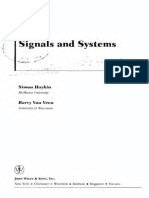EE 4314 - Control Systems: Inverse Laplace Transform
EE 4314 - Control Systems: Inverse Laplace Transform
Uploaded by
Nick NumlkCopyright:
Available Formats
EE 4314 - Control Systems: Inverse Laplace Transform
EE 4314 - Control Systems: Inverse Laplace Transform
Uploaded by
Nick NumlkOriginal Title
Copyright
Available Formats
Share this document
Did you find this document useful?
Is this content inappropriate?
Copyright:
Available Formats
EE 4314 - Control Systems: Inverse Laplace Transform
EE 4314 - Control Systems: Inverse Laplace Transform
Uploaded by
Nick NumlkCopyright:
Available Formats
1
Copyright F.L. Lewis 1999
All rights reserved
EE 4314 - Control Systems
LECTURE 3
INVERSE LAPLACE TRANSFORM
INVERSE LAPLACE TRANSFORM
Given a time function f(t), its unilateral Laplace transform is given by
0
) ( ) ( dt e t f s F
st
,
where j s + is a complex variable. The inverse Laplace transform is a complex
integral given by
j
j
st
ds e s F
j
t f ) (
2
1
) ( ,
where the integration is performed along a contour in the complex plane. Since this is
tedious to deal with, one usually uses the Cauchy theorem to evaluate the inverse
transform using
st
e s F of residues enclosed t f ) ( ) ( .
In this course we shall use lookup tables to evaluate the inverse Laplace
transform. An abbreviated table of Laplace transforms was given in the previous lecture.
The text has a more detailed table. Given a realistic Laplace transform with several poles
and zeros, it is not likely to be contained in the table. However, it is easy to break a
transform down as into sum of simpler transforms that are in the table by using the
Partial Fraction Expansion (PFE).
PARTIAL FRACTION EXPANSION (PFE)
The PFE is simply a technique for splitting a rational transform up into a sum of
simpler terms.
2
Case 1. Non-Repeated Poles
Let a rational polynomial function of s be given as
) ( ) (
) (
) (
1
s d p s
s n
s Y
+
where n(s) is the numerator and d(s) is a polynomial which does not have any poles at
1
p s . The relative degree, defined as the degree of the denominator (e.g.
) ( ) (
1
s d p s + ) minus the degree of the numerator n(s), should be at least 1.
One may split out a term with divisor ) (
1
p s + and write
) (
) ( ) ( ) (
) (
) (
1
1
1
1
s Y
p s
K
s d p s
s n
s Y +
+
where K
1
is known as the residue of the pole at
1
p s , and ) (
1
s Y is a polynomial
fraction that does not have any poles at
1
p s . To determine the residue K
1
one may
write
) ( ) (
) (
) (
) ( ) (
1 1 1 1
s Y p s K
s d
s n
s Y p s + + + .
Now evaluating all terms at
1
p s , the last term becomes zero and one obtains
1
) ( ) (
1 1
p s
s Y p s K
+
Example 1- Non-Repeated Poles
Find the inverse Laplace transform of
6 11 6
) (
2 3
+ + +
s s s
s
s Y .
First note that this function is not in the transform table. To write it as the sum of terms
that are in the table, factor the denominator to obtain
) 3 )( 2 )( 1 (
) (
+ + +
s s s
s
s Y .
Now write
3 2 1
) (
3 2 1
+
+
+
+
+
s
K
s
K
s
K
s Y
and evaluate the residues by
3
2
1
) 3 1 )( 2 1 (
) 1 (
) 3 )( 2 (
1
1
+ +
+ +
s
s s
s
K
2
) 3 2 )( 1 2 (
) 2 (
) 3 )( 1 (
2
2
+ +
+ +
s
s s
s
K
2
3
) 2 3 )( 1 3 (
) 3 (
) 2 )( 1 (
3
3
+ +
+ +
s
s s
s
K
Therefore
3
2
3
2
2
1
2
1
) (
+
+
+
+
+
s s s
s Y .
Check this now by combining the terms back into one fraction to get the original Y(s).
Each term is now in the table, whence one may write down the inverse Laplace
transform as
) ( )
2
3
2
2
1
( ) (
1
3 2
t u e e e t y
t t t
+ .
We multiplied by the unit step to make this function causal.
Case 2- Repeated Real Poles
Let a rational polynomial function of s with relative degree of at least 1 be given
as
) ( ) (
) (
) (
1
s d p s
s n
s Y
n
+
where n(s) is the numerator and d(s) is a polynomial which does not have any poles at
1
p s . This has a pole repeated n times at
1
p s .
One may show that
) (
) ( ) ( ) ( ) ( ) (
) (
) (
1
1
1
1
1
12
1
11
1
s Y
p s
K
p s
K
p s
K
s d p s
s n
s Y
n
n n n
+
+
+ +
+
+
+
L
where K
11
is the residue of the pole at
1
p s , and ) (
1
s Y is a polynomial fraction that
does not have any poles at
1
p s . Note that, for a pole of order n, one requires in the
PFE all terms of order n and below.
To determine the residue K
11
one may proceed as above and use
4
1
) ( ) (
1 11
p s
n
s Y p s K
+ .
The other numerator terms K
ij
can be determined using some derivative formulas given in
the text. An alternative technique is given in the next example.
Example 2- Repeated Real Pole
Find the inverse Laplace transform of
2 5 4
) (
2 3
+ + +
s s s
s
s Y .
First, factor the denominator to obtain
) 2 ( ) 1 (
) (
2
+ +
s s
s
s Y .
This may be written as the sum of terms
2 1 ) 1 ( ) 2 ( ) 1 (
) (
2 12
2
11
2
+
+
+
+
+
+ +
s
K
s
K
s
K
s s
s
s Y . (1)
The residues K
11
and K
2
are determined using the technique in Example 1 to obtain
2
2
1 ) 1 (
1
) (
12
2
+
+
+
+
+
s s
K
s
s Y .
To evaluate the term K
12
, one notes that the equality (1) must hold for all values
of s. Select therefore a convenient value of s, evaluate (1), and solve for K
12
. A very
easy value is s=0, for which
2 0
2
1 0 ) 1 0 (
1
) 2 0 ( ) 1 0 (
0
) 0 (
12
2 2
+
+
+
+
+
+ +
K
Y ,
yielding K
12
= 2.
Therefore, the PFE is
2
2
1
2
) 1 (
1
) (
2
+
+
+
+
+
s s s
s Y ,
whence the Laplace transform table gives the time function
) ( ) 2 2 ( ) (
1
2
t u e te e t y
t t t
.
Note that one may not select a value s corresponding to a pole in using (1) to
determine K
12
, since at the pole values Y(s) blows up to infinity.
5
Case 3- Complex Pole Pair
Let a rational polynomial function of s with relative degree of at least 1 be given
as
) ( ) ) ((
) (
) (
2 2
s d s
s n
s Y
+ +
where n(s) is the numerator and d(s) is a polynomial which does not have the factor
) ) ((
2 2
+ + s .
We have seen in the previous lecture that
( )( ) ) ( ) ( ) ) ((
2 2
j s j s s + + + + + ,
so this factor corresponds to a complex pole pair at j s t . In this course we shall
not write factors using 'j'. We shall keep complex pole pairs together in the quadratic
form.
One may split out a term with divisor ) ) ((
2 2
+ + s and write
) (
) ) ( ) ( )) ) ((
) (
) (
1 2 2 2 2
s Y
s
b as
s d s
s n
s Y +
+ +
+
+ +
where ) (
1
s Y is a polynomial fraction that does not contain the factor ) ) ((
2 2
+ + s .
Note that the term above the quadratic factor has degree one less, namely, in this case,
one.
The next example shows how to solve for the constants a and b.
Example 3- Imaginary Pole Pair
Find the inverse Laplace transform of
8 4 2
1
) (
2 3
+ + +
+
s s s
s
s Y .
Factor the denominator and write the PFE to obtain
4 2
8
1
4 2 ) 4 )( 2 (
1
) (
2 2
1
2
+
+
+
+
+
+
+
+
+ +
+
s
b as
s s
b as
s
K
s s
s
s Y , (2)
where the residue at s=-2 was determined as in Example 1.
To find a and b, select two values of s and evaluate both sides of (2). From the
resulting algebraic equations, one may solve for a and b. If s=0 is not a pole, one may
select s=0 and find b first, then find a using another value of s. If s=0 is a pole, one must
6
select two nonzero values of s, which generally give two simultaneous equations for a
and b.
Since zero is not a pole in this example, evaluate (2) at s=0 to obtain
4 0
0 .
2 0
8
1
) 4 0 )( 2 0 (
1 0
) 0 (
2 2
+
+
+
+
+ +
+
b a
Y .
Solving yields b=3/4.
Selecting now s=1 gives
4 1
4
3
2 1
8
1
) 4 1 )( 2 1 (
1 1
) 1 (
2 2
+
+
+
+
+ +
+
a
Y ,
which yields a=1/8.
The PFE is thus given by
4
4
3
4
8
1
2
8
1
4
4
3
8
1
2
8
1
) 4 )( 2 (
1
) (
2 2 2 2
+
+
+
+
+
+
+
+
+
+ +
+
s s
s
s s
s
s s s
s
s Y .
Now the transform table says that
) ( 2 sin
8
3
2 cos
8
1
8
1
) (
1
2
t u t t e t y
t
,
_
+ + .
Note that the poles are at 2 , 2 j s t . However, we did not use any terms in 'j' in
this evaluation. We kept the imaginary pole pair together as
2 2
+ s .
Example 4- Complex Pole Pair
Find the inverse transform of
) 7 4 )( 1 (
2
) (
2
+ + +
s s s
s
s Y .
Using the techniques in Example 3 one may see that
7 4
4
13
4
3
1
4
3
) (
2
+ +
+
+
+
s s
s
s
s Y .
To find the inverse transform, write the denominator in the form
2 2
) ( + + s to get
7
3 ) 2 (
4
13
4
3
1
4
3
) (
2
+ +
+
+
+
s
s
s
s Y .
Now use the table to see that
) ( 3 sin
3 4
7
3 cos
4
3
4
3
) (
1
2
t u t t e e t y
t t
1
]
1
,
_
+ +
.
Note that the complex poles are at 3 2 j s t , yet we never use 'j' in this
evaluation. We are careful to keep the complex pair together in the quadratic term
2 2
) ( + + s . Note further that the exponential decay term of the complex pair is
t
e
,
while the frequency of oscillation is given by 3 .
Case 4-Relative Degree Equal to Zero
In control theory we do not use Laplace transforms with relative degree less than
zero. If the relative degree of Y(s) is equal to zero, then prior to using the above PFE
techniques one must do one step of long division to write
) ( ) (
1
s Y const s Y +
where const is a constant and the relative degree of Y
1
(s) is one or more.
Example 5- Relative Degree Zero
Find the inverse Laplace transform of
6 11 6
18 34 18 3
) (
2 3
2 3
+ + +
+ + +
s s s
s s s
s Y .
This transform has relative degree of zero, so the PFE does not give the correct
answer. To find the time function, perform one step of long division to write
6 11 6
3 ) (
2 3
+ + +
+
s s s
s
s Y .
The second term now has relative degree of 1 and one can proceed using the techniques
given above.
In fact, using the results of Example 1, one sees that
) ( )
2
3
2
2
1
( ) ( ) (
1
3 2
0
t u e e e t u t y
t t t
+ + .
8
If the transform relative degree is zero, it means that the time function contains the
impulse function u
0
(t).
You might also like
- First Periodical Test in Mathematics 8Document7 pagesFirst Periodical Test in Mathematics 8Raisa Sontillano92% (77)
- Assignment 4Document2 pagesAssignment 4Komal SinghNo ratings yet
- LP in Math Divide FractionDocument3 pagesLP in Math Divide FractionChristine Joyce Lacsina Lacsamana100% (6)
- Chapter 2 - Laplace Transform PDFDocument34 pagesChapter 2 - Laplace Transform PDFSritaran Balakrishnan100% (1)
- Solutions Teoria ComputadoresDocument30 pagesSolutions Teoria ComputadoresJpmn Pm NlkNo ratings yet
- RoaLogic RV12 RISCV DatasheetDocument73 pagesRoaLogic RV12 RISCV DatasheetJoão VictorNo ratings yet
- EECS 233 Final Exam Cheat Sheet PDFDocument2 pagesEECS 233 Final Exam Cheat Sheet PDFkmlkmlas100% (1)
- 99-881-0001-0001-Combat Systems Vol 1 Sensor Elements Part-IDocument602 pages99-881-0001-0001-Combat Systems Vol 1 Sensor Elements Part-INick NumlkNo ratings yet
- Indeterminate FormsDocument6 pagesIndeterminate FormsGabriel Dave AlamoNo ratings yet
- Notes LT1Document21 pagesNotes LT1deathesNo ratings yet
- Signals & System Using Matlab - RIT PampadyDocument45 pagesSignals & System Using Matlab - RIT PampadyAnish BennyNo ratings yet
- Shakti ReportDocument24 pagesShakti Reportsachin m cNo ratings yet
- AdcDocument69 pagesAdc123kailashNo ratings yet
- C++ ReferenceDocument2 pagesC++ ReferenceAlessio BianchettiNo ratings yet
- Handout 4: Iii. Turing MachinesDocument12 pagesHandout 4: Iii. Turing MachinesJosue David Hernandez ViloriaNo ratings yet
- Solving Differential Equations in JavaDocument36 pagesSolving Differential Equations in Javamalekan2005100% (1)
- Discrete-Time Fourier Transform: XN X XneDocument36 pagesDiscrete-Time Fourier Transform: XN X Xneyadavsticky5108No ratings yet
- Department of Mathematics Manipal Institute of Technology, ManipalDocument2 pagesDepartment of Mathematics Manipal Institute of Technology, Manipalsaptarshi hoom choudhuryNo ratings yet
- Risc VDocument5 pagesRisc VOlhaNo ratings yet
- Design of A RISC Microcontroller Core in 48 HoursDocument11 pagesDesign of A RISC Microcontroller Core in 48 HoursPulkit TrivediNo ratings yet
- Pic10 Risc DesignDocument169 pagesPic10 Risc DesignDai Thang TranNo ratings yet
- Data Structures and Object Orientedprogramming in C++Document169 pagesData Structures and Object Orientedprogramming in C++bobsgallyNo ratings yet
- Week 4 OOPDocument16 pagesWeek 4 OOPArslan Baloch AshuNo ratings yet
- Flash ADC MidsemDocument9 pagesFlash ADC MidsemBikashKumarMoharanaNo ratings yet
- Clang AstDocument6 pagesClang Astatom tuxNo ratings yet
- Ultra-Low Power VLSI CircuitDocument27 pagesUltra-Low Power VLSI CircuitRockstar_rohithNo ratings yet
- Fourier AnalysisDocument24 pagesFourier AnalysisEustahije BrzicNo ratings yet
- Signals and Systems - HaykinDocument438 pagesSignals and Systems - HaykinAndré BertoniNo ratings yet
- AnswersDocument11 pagesAnswersSean TuasonNo ratings yet
- A Look at TCLDocument22 pagesA Look at TCLZachary Hayes100% (2)
- Computer Graphics Lab 3Document3 pagesComputer Graphics Lab 3sania_sania3467No ratings yet
- Linear Algebra SolutionsDocument5 pagesLinear Algebra SolutionsGerrit LaneNo ratings yet
- Gilbert Strang-The Algebra of Elimination (Expository Notes) (2011) PDFDocument20 pagesGilbert Strang-The Algebra of Elimination (Expository Notes) (2011) PDFTimmavajjula Venkata KarthikNo ratings yet
- ZhengchenDocument139 pagesZhengchenAnh PhanNo ratings yet
- Genetic AlgorithmDocument6 pagesGenetic AlgorithmShashikant ChaurasiaNo ratings yet
- Chess and Variations ofDocument6 pagesChess and Variations ofFrancesco GalofaroNo ratings yet
- Cayley HamiltonDocument2 pagesCayley HamiltonSHASWAT SRIVASTAVA IET Lucknow StudentNo ratings yet
- Algorithm W Step by Step: Martin Grabm UllerDocument7 pagesAlgorithm W Step by Step: Martin Grabm Uller简文章No ratings yet
- Graph Theory: Graph of A Function Graph (Disambiguation)Document8 pagesGraph Theory: Graph of A Function Graph (Disambiguation)Navi_85No ratings yet
- Lab 5 Music Player and Audio Amp Fall 2014Document8 pagesLab 5 Music Player and Audio Amp Fall 2014SteveNo ratings yet
- Chapter One: Complexity Theory Is A Central Topic in Theoretical Computer Science. It HasDocument65 pagesChapter One: Complexity Theory Is A Central Topic in Theoretical Computer Science. It HasDawit BassaNo ratings yet
- Sylvester Criterion For Positive DefinitenessDocument4 pagesSylvester Criterion For Positive DefinitenessArlette100% (1)
- Volterra SeriesDocument5 pagesVolterra SeriesAnimasahun Olamide HammedNo ratings yet
- Dokumen - Tips Microprocessor and Interfacing by Douglas Hall PDF Avtardouglas V Hall Is TheDocument2 pagesDokumen - Tips Microprocessor and Interfacing by Douglas Hall PDF Avtardouglas V Hall Is Thehritika dhasal0% (2)
- Lecture # 16 PDFDocument24 pagesLecture # 16 PDFMuhammad AdilNo ratings yet
- TCL TutorialDocument161 pagesTCL TutorialvsalaiselvamNo ratings yet
- Shannon's Information Theory - Science4AllDocument13 pagesShannon's Information Theory - Science4AllKevin E. Godinez OrtizNo ratings yet
- CCS TivaWareDocument26 pagesCCS TivaWareJoginder YadavNo ratings yet
- Descrete Mathematical StructuresDocument4 pagesDescrete Mathematical StructuresTêçhîê SããkêthNo ratings yet
- Z TransformDocument21 pagesZ Transformadil1122100% (3)
- AP Physics B EquationsDocument2 pagesAP Physics B EquationsspoonrooNo ratings yet
- Singular Value Decomposition - Lecture NotesDocument87 pagesSingular Value Decomposition - Lecture NotesRoyi100% (1)
- Prologue: 0.1 Books and AlgorithmsDocument9 pagesPrologue: 0.1 Books and AlgorithmsSivapremjiNo ratings yet
- Calculus and VectorsDocument11 pagesCalculus and VectorsBindo100% (1)
- Nonlinear Programming Solution ADocument65 pagesNonlinear Programming Solution AAlka ChoudharyNo ratings yet
- Tables Derivative IntegralDocument54 pagesTables Derivative Integralshiva121294No ratings yet
- Hilbert Space Methods in Partial Differential EquationsFrom EverandHilbert Space Methods in Partial Differential EquationsRating: 4.5 out of 5 stars4.5/5 (2)
- Manpads ComponentsDocument16 pagesManpads ComponentsNick NumlkNo ratings yet
- F 16 Platform BrochureDocument16 pagesF 16 Platform BrochureNick Numlk50% (2)
- B 0150061212Document4 pagesB 0150061212Nick NumlkNo ratings yet
- 14313A ch10Document32 pages14313A ch10Nick NumlkNo ratings yet
- EKKO II - Digital RadarjammingDocument2 pagesEKKO II - Digital RadarjammingNick NumlkNo ratings yet
- Fact Sheet - Fan SongDocument4 pagesFact Sheet - Fan SongNick NumlkNo ratings yet
- Fact Sheet - Snow DriftDocument1 pageFact Sheet - Snow DriftNick Numlk0% (1)
- Worldwide Equipment GuideDocument414 pagesWorldwide Equipment Guidealex.rocha_silva9359100% (17)
- Fact Sheet - Tin ShieldDocument2 pagesFact Sheet - Tin ShieldNick NumlkNo ratings yet
- Chart For EW OfficerDocument13 pagesChart For EW OfficerNick NumlkNo ratings yet
- Sa-3 GoaDocument5 pagesSa-3 GoaNick Numlk100% (2)
- Fact Sheet - Big BirdDocument2 pagesFact Sheet - Big BirdNick Numlk100% (3)
- Fact Sheet - Bill BoardDocument2 pagesFact Sheet - Bill BoardNick Numlk100% (1)
- Fact Sheet - Bar LockDocument2 pagesFact Sheet - Bar LockNick Numlk100% (1)
- Fact Sheet - Clam ShellDocument2 pagesFact Sheet - Clam ShellNick NumlkNo ratings yet
- Manpads ComponentsDocument16 pagesManpads ComponentsNick NumlkNo ratings yet
- Russian Military AircraftDocument219 pagesRussian Military AircraftJohn John100% (1)
- Example: Terminal StackingDocument40 pagesExample: Terminal StackingNick NumlkNo ratings yet
- Naval 1Document12 pagesNaval 1Nick NumlkNo ratings yet
- THURBONDocument2 pagesTHURBONNick NumlkNo ratings yet
- Whole Numbers (PG 1-11)Document11 pagesWhole Numbers (PG 1-11)Crystal LeeNo ratings yet
- Multiplying and Dividing Fractions Part 1: Multiplying FractionsDocument16 pagesMultiplying and Dividing Fractions Part 1: Multiplying FractionsHasan FarazNo ratings yet
- WARRANTS Key Issues and TakeawaysDocument6 pagesWARRANTS Key Issues and TakeawaysEric MooreNo ratings yet
- Jesus, The Rock of All Ages Christian SchoolDocument7 pagesJesus, The Rock of All Ages Christian SchoolJohn Lester Burca Magdaraog100% (1)
- Yearly Lesson Plan Mathematics Form Three 2013Document15 pagesYearly Lesson Plan Mathematics Form Three 2013Nur BainiNo ratings yet
- Sat Practice Test 2 Math Calculator Assistive TechnologyDocument76 pagesSat Practice Test 2 Math Calculator Assistive TechnologyJawad KhawajaNo ratings yet
- Smart Notebook LessonDocument5 pagesSmart Notebook Lessonapi-255095971No ratings yet
- Math Test QuestionsDocument3 pagesMath Test QuestionsAngelou TingsonNo ratings yet
- Benny's Conception of Rules and Answers in IPI MathematicsDocument21 pagesBenny's Conception of Rules and Answers in IPI MathematicsnopeNo ratings yet
- X X X X: Edexcel Internal Review 1Document25 pagesX X X X: Edexcel Internal Review 1Panagiotis ScordisNo ratings yet
- Week 2 Weebly ChartDocument2 pagesWeek 2 Weebly Chartapi-272371264100% (1)
- Maths Hong Kong Reform PDFDocument5 pagesMaths Hong Kong Reform PDFanon_390897907No ratings yet
- Quantitive APTITUDEDocument61 pagesQuantitive APTITUDEMrigakshi Sharma Barthakur75% (4)
- Class-10 Army School Holiday HomeworkDocument41 pagesClass-10 Army School Holiday HomeworkRAVINDRA SINGH SAHAB0% (1)
- Partial FractionsDocument4 pagesPartial FractionsrodwellheadNo ratings yet
- Math Lesson WorksheetDocument5 pagesMath Lesson Worksheetapi-283894138No ratings yet
- Computer Ion ND ArchitectureDocument124 pagesComputer Ion ND ArchitectureedudivyaNo ratings yet
- CFD 1st UnitDocument15 pagesCFD 1st UnitObula Reddy KNo ratings yet
- 2015 WMI Grade 6 Questions Part 2 PDFDocument2 pages2015 WMI Grade 6 Questions Part 2 PDFสฮาบูดีน สาและ100% (2)
- 3.6a Fraction of A Whole NumberDocument3 pages3.6a Fraction of A Whole NumberMegan EarlyNo ratings yet
- Math 5 3rd Q Ratio ProportionDocument43 pagesMath 5 3rd Q Ratio ProportionSteve MaiwatNo ratings yet
- Nift MFM Mock Test (Gat) 1Document11 pagesNift MFM Mock Test (Gat) 1BlacksheepResources100% (2)
- AIME Exams MergedDocument18 pagesAIME Exams MergedmikintyNo ratings yet
- Gyrator AnalysisDocument6 pagesGyrator Analysismieczu100% (1)
- TCS Placement Paper 1 To 14Document146 pagesTCS Placement Paper 1 To 14Abhay PatilNo ratings yet
- Grade 6 Percentage: Answer The QuestionsDocument3 pagesGrade 6 Percentage: Answer The QuestionsAnosha AsifNo ratings yet
- 1.practice Set IBPS CWE CLERK-IV PDFDocument15 pages1.practice Set IBPS CWE CLERK-IV PDFamitukumarNo ratings yet













































































































